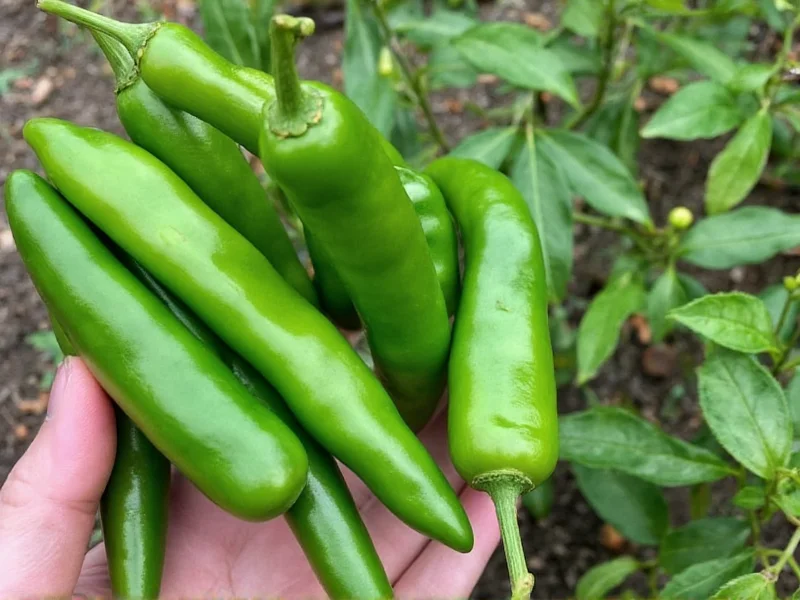Understanding why your serrano peppers aren't hot requires examining both cultivation practices and the biological factors that influence capsaicin development. Serrano peppers typically range from 10,000 to 23,000 Scoville Heat Units (SHU), but various environmental and agricultural conditions can significantly reduce their expected spiciness.
The Science Behind Pepper Heat
Capsaicinoids, primarily capsaicin, create the burning sensation we associate with hot peppers. These compounds develop in the placenta (white ribs) of peppers and distribute throughout the fruit. Serrano peppers produce capsaicin as a defense mechanism against predators and fungi. When plants experience mild stress, they often increase capsaicin production.
Top 7 Reasons Your Serrano Peppers Lack Heat
| Factor | Impact on Heat | Solution |
|---|---|---|
| Inconsistent Watering | Overwatering dilutes capsaicin; drought stress increases heat | Water deeply but less frequently once established |
| Excessive Nitrogen Fertilizer | Promotes leaf growth over capsaicin production | Use balanced fertilizer with higher phosphorus content |
| Harvesting Too Early | Peppers gain heat as they mature and change color | Allow peppers to fully ripen to red for maximum heat |
| Inadequate Sunlight | Less than 6 hours of sun reduces capsaicin development | Ensure plants receive 8+ hours of direct sunlight daily |
| Cool Growing Temperatures | Temperatures below 70°F slow capsaicin production | Grow during warm season; use row covers in cooler climates |
Environmental Factors That Reduce Pepper Heat
Temperature fluctuations significantly impact serrano pepper heat levels. These peppers thrive in consistent warmth between 70-90°F (21-32°C). When temperatures drop below 60°F (15°C), capsaicin production slows dramatically. Similarly, extreme heat above 95°F (35°C) can stress plants to the point where they redirect energy away from capsaicin development.
Soil composition plays a crucial role in pepper heat development. While serranos prefer well-draining soil, excessive organic matter or nitrogen-rich fertilizers promote vegetative growth at the expense of capsaicin production. The ideal soil pH for hot peppers ranges between 6.2 and 7.0. Soil testing before planting can prevent common nutrient imbalances that affect heat levels.
Genetic and Maturity Factors
Not all serrano pepper plants produce identical heat levels. Genetic variation exists between different seed sources and even among plants from the same seed packet. Some commercial varieties have been selectively bred for milder flavors, which could explain unexpectedly mild peppers.
Harvest timing dramatically affects heat perception. Green serranos contain less capsaicin than fully ripened red serranos. As peppers mature and change color from green to red, their capsaicin concentration increases by up to 30%. The white pithy ribs inside the pepper contain the highest concentration of capsaicin, so removing these reduces perceived heat.
Testing Your Peppers' Actual Heat Level
Before concluding your serranos lack heat, consider proper testing methods. Capsaicin concentration varies within individual peppers - the tip is usually milder than the stem end. To accurately assess heat:
- Cut a small piece from the shoulder area (near the stem)
- Wait 15 seconds before tasting to avoid overwhelming your palate
- Start with a tiny amount and gradually increase
- Have dairy products available to neutralize excessive heat
Remember that human perception of heat varies significantly. What seems mild to an experienced chili eater might feel extremely hot to someone with lower spice tolerance. Comparing your serranos to known references like jalapeños (2,500-8,000 SHU) can provide better context.
Improving Heat in Future Harvests
If you want hotter serrano peppers next season, implement these evidence-based techniques:
- Water strategically: Reduce watering frequency as harvest approaches to create mild drought stress
- Optimize sunlight: Ensure plants receive 8-10 hours of direct sun daily
- Use appropriate fertilizer: Switch to phosphorus-rich fertilizer during flowering
- Allow full ripening: Harvest when peppers turn bright red for maximum heat
- Provide consistent warmth: Grow in containers that can be moved to sunny spots
Many experienced pepper growers intentionally stress their plants slightly by reducing water 1-2 weeks before harvest. This technique, called “controlled stress,” can increase capsaicin production by up to 25% without damaging the plant. However, avoid extreme stress that could cause plant damage or reduced yields.
When Mild Peppers Might Be Beneficial
While many seek maximum heat, milder serranos have culinary advantages. They provide the distinctive serrano flavor profile with less intense heat, making them more versatile for dishes where you want pepper flavor without overwhelming spice. Mild serranos work better in fresh salsas, salads, and dishes for those with lower spice tolerance.
Interestingly, research shows that capsaicin production varies not only between plants but also between individual fruits on the same plant. The first fruits often contain less capsaicin than later harvests as the plant matures and environmental conditions stabilize.











 浙公网安备
33010002000092号
浙公网安备
33010002000092号 浙B2-20120091-4
浙B2-20120091-4